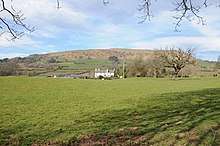Llanddewi Court
Llanddewi Court, Llanddewi Skirrid, Monmouthshire, Wales, is a Grade II* listed house dating from the late 16th century. It is an example of a "double-house", a building in two sections, originally without interconnections, and designed to accommodate two families.
| Llanddewi Court | |
|---|---|
 "a specially interesting late C16 'double' house" | |
| Type | House |
| Location | Llanddewi Skirrid, Monmouthshire |
| Coordinates | 51.673°N 2.988°W |
| Built | late 16th century |
| Architectural style(s) | Vernacular architecture |
| Governing body | Privately owned |
Listed Building – Grade II* | |
| Official name: Llanddewi Court | |
| Designated | 4 March 1952 |
| Reference no. | 2676 |
Listed Building – Grade II | |
| Official name: Oxhouse at Llanddewi Court | |
| Designated | 4 March 1952 |
| Reference no. | 2677 |
Listed Building – Grade II | |
| Official name: Barn at Llanddewi Court | |
| Designated | 18 November 1980 |
| Reference no. | 2678 |
 Location of Llanddewi Court in Monmouthshire | |
History and architecture
Cadw gives a construction date for the court of the late 16th century,[1] although the architectural historian John Newman describes it as 15th century in origin.[2] Sir Cyril Fox and Lord Raglan, in the second of their multi-volume history, Monmouthshire Houses, describe Llanddewi as a "double house – in two parts apparently without contemporary intercommunication".[3] Later historians, including those responsible for the Cadw listing, are less certain, noting the close similarities to the White Hart Inn in nearby Llangybi which had a contemporary connecting passage.[1] The house, still a private home,[4] has been altered in subsequent centuries, although Newman and Cadw disagree as to the extent of this rebuilding, Newman describing the court as "much enlarged, altered and modernized"[2] while Cadw contends that the exterior has seen little alteration, although it acknowledges significant internal modernization.[1]
Llanddewi Court is of two storeys and is constructed of old red sandstone rubble which has been whitewashed in parts. The roof is of Welsh slate. The building has a Grade II* listing, in recognition of its "specially interesting" plan.[1] The court's barn, and its ox house have their own Grade II listings.[5][6]
Notes
- "Listed Buildings – Full Report – HeritageBill Cadw Assets – Reports". cadwpublic-api.azurewebsites.net.
- Newman 2000, p. 270.
- Fox & Raglan 1994, p. 60.
- "Llanddewi Court" (PDF). On The Market.
- "Listed Buildings – Full Report – HeritageBill Cadw Assets – Reports". cadwpublic-api.azurewebsites.net.
- "Listed Buildings – Full Report – HeritageBill Cadw Assets – Reports". cadwpublic-api.azurewebsites.net.
References
- Fox, Cyril; Raglan, Lord (1994). Sub-Medieval Houses, c. 1550–1610. Monmouthshire Houses. 2. Cardiff: Merton Priory Press Ltd & The National Museum of Wales. ISBN 0952000989.
- Newman, John (2000). Gwent/Monmouthshire. The Buildings of Wales. London: Penguin. ISBN 0-14-071053-1.